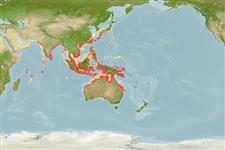Common names from other countries
分类 / Names
俗名 | 同种异名 | Catalog of Fishes(属, 种) | ITIS | CoL | WoRMS | Cloffa
Teleostei >
Carangaria/misc (Various families in series Carangaria) >
Latidae (Lates perches)
Etymology: Lates: Latin, lateo, latere = to be hidden.
More on author: Bloch.
Environment: milieu / climate zone / depth range / distribution range
生态学
海洋; 淡水; 半咸淡水 居于水底的; 降海洄游 (Ref. 51243); 深度上下限 10 - 40 m (Ref. 7261). 熱帶; 15°C - 28°C (Ref. 2060); 49°N - 26°S, 56°E - 155°E (Ref. 54239)
Indo-West Pacific: eastern edge of the Persian Gulf to China, Taiwan and southern Japan, southward to southern Papua New Guinea and northern Australia.
印度-西太平洋: 波斯灣到中國的東方邊緣, 台灣與日本南部, 向南至巴布亞新幾內亞南部與澳洲北部。
Length at first maturity / 大小 / 重量 / 年龄
Maturity: Lm 44.5, range 29 - 60 cm
Max length : 200 cm TL 雄鱼/尚未辨别雌雄; (Ref. 7050); common length : 150 cm NG 雄鱼/尚未辨别雌雄; (Ref. 9799); 最大体重: 60.0 kg (Ref. 28138); 最大年龄: 35 年 (Ref. 125591)
背棘 (总数) : 7 - 9; 背的软条 (总数) : 10 - 11; 臀棘: 3; 臀鳍软条: 7 - 8. Body elongate; mouth large, slightly oblique, upper jaw extending behind the eye. Lower edge of preopercle serrated, with strong spine at its angle; opercle with a small spine and with a serrated flap above the origin of the lateral line. Caudal fin rounded.
细长的身体; 嘴大的,些微斜, 上颌延伸到眼后面。 被锯齿状的前鳃盖骨的下缘, 藉由硬棘在其角上; 鳃盖有一根小的棘而且具有一个锯齿状的在侧线的起源上面的鳃盖。 尾鳍圆的。
Found in coastal waters, estuaries and lagoons, in clear to turbid water (Ref. 5259, 44894). A diadromous fish, inhabiting rivers before returning to the estuaries to spawn. A protandrous hermaphrodite (Ref. 32209). Larvae and young juveniles live in brackish temporary swamps associated with estuaries, and older juveniles inhabit the upper reaches of rivers (Ref. 6390, 44894). Have preference for cover on undercut banks, submerged logs and overhanging vegetation (Ref. 44894). Feed on fishes and crustaceans. They reach 1500-3000 g in one year in ponds under optimum conditions (Ref. 11046, 44894). Juveniles also eat insects (Ref. 44894). Sold fresh and frozen; consumed steamed, pan-fried, broiled and baked (Ref. 9987). A very popular and sought-after fish of very considerable economic importance (Ref. 9799). Presently used for aquaculture in Thailand, Indonesia and Australia (Ref. 9799). Australia's most important commercial fish and one of the most popular angling species (Ref. 44894).
在清澈至混浊的水,发现于沿岸水域,河口与舄湖了。 (参考文献 5259,44894) 一个河海洄游性鱼, 在回到河口产卵之前居住于河。 一个雄性先熟的雌雄同体.(参考文献 32209) 仔鱼与年幼的稚鱼生活于半咸淡的与河口相连的暂时性沼泽,而且更老稚鱼栖息于河的上游。 (参考文献 6390,44894) 在堤岸下, 水下的圆木与上悬的植物上有对表面的偏爱。 (参考文献 44894) 捕食鱼与甲壳动物。 他们在一年中在最适宜的情况在池塘中达到 1500-3000 g 。 (参考文献 11046,44894) 稚魚也吃昆蟲。 (參考文獻 44894) 生鮮販賣了與冷凍的; 消費蒸, 油鍋炸的﹐火烤的與燒烤的.(參考文獻 9987) 一個非常具有經濟重要性的非常受歡迎而受喜愛魚.(參考文獻 9799) 目前用來了在泰國,印尼與澳洲的水產業。 (參考文獻 9799) 澳洲的最重要商業的魚與最受歡迎釣魚種之一.(參考文獻 44894)
Breed in estuaries throughout the Indo-Pacific. Maturing male barramundi migrate downstream from freshwater habitats at the start of the wet (monsoon) season to spawn with resident females in estuaries (Ref. 27132) and on tidal flats outside the mouths of rivers (Ref. 6390).
Barramundi spawn on the full moon and new moon, primarily at the beginning of an incoming tide which carries the eggs into the estuary (Ref. 28135).
Barramundi are broadcast spawners that aggregate to spawn (Ref. 6390). Spawning aggregations occur in or around the mouths of rivers (Ref. 28132). While adults and juveniles are capable of living in fresh water, brackish waters are required for embryonic development (Ref. 6136). Female barramundi are capable of producing large numbers of eggs, with estimates as high as 2.3 million eggs per kg of body weight (Ref. 28134).
Barramundi are protandrous hermaphrodites, i.e., they undergo sex reversion during their life cycle. Females are generally absent in the smaller length classes, but dominate larger length classes. Most barramundi mature first as males and function as males for one or more spawning seasons before undergoing sex inversion. A few females will develop directly from immature fish (Ref. 28132). Similarly, some males may never undergo sex inversion (Ref. 28132). Also Ref. 103751.印度-西太平洋: 波斯灣到中國的東方邊緣, 台灣與日本南部, 向南至巴布亞新幾內亞南部與澳洲北部。
Larson, H., 1999. Order Perciformes. Suborder Percoidei. Centropomidae. Sea perches. p. 2429-2432. In K.E. Carpenter and V.H. Niem (eds.) FAO species identification guide for fishery purposes. The living marine resources of the Western Central Pacific. Volume 4. Bony fishes part 2 (Mugilidae to Carangidae). FAO, Rome. (Ref. 9799)
CITES (Ref. 128078)
Not Evaluated
人类利用
渔业: 高经济性; 养殖: 商业性; 游钓鱼种: 是的; 水族馆: 公众的水族馆
工具
特别资料
下载 XML
网络资源
Estimates based on models
Preferred temperature (Ref.
115969): 25 - 29.1, mean 28.3 (based on 710 cells).
Phylogenetic diversity index (Ref.
82804): PD
50 = 0.5006 [Uniqueness, from 0.5 = low to 2.0 = high].
Bayesian length-weight: a=0.00977 (0.00619 - 0.01542), b=3.00 (2.86 - 3.14), in cm Total Length, based on LWR estimates for this species & Genus-body shape (Ref.
93245).
营养阶层 (Ref.
69278): 3.8 ±0.60 se; based on food items.
回复力 (Ref.
120179): 中等的, 族群倍增时间最少 1.4 - 4.4年 (K=0.09-0.13; tm=1-5; Fec = 15,300,000).
Prior r = 0.52, 95% CL = 0.34 - 0.77, Based on 3 full stock assessments.
Fishing Vulnerability (Ref.
59153): High to very high vulnerability (69 of 100).
Climate Vulnerability (Ref.
125649): High to very high vulnerability (72 of 100).
